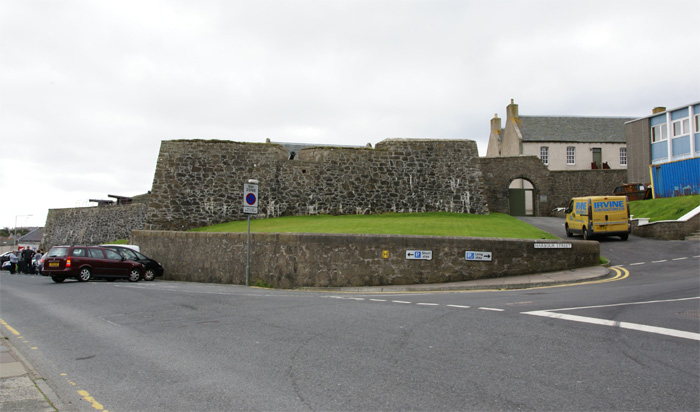Fort Charlotte, Shetland on:
[Wikipedia]
[Google]
[Amazon]



 Fort Charlotte in the centre of
Fort Charlotte in the centre of
Fort Charlotte
– Information at Historic Scotland Buildings and structures completed in 1653 Buildings and structures completed in 1665 Category A listed buildings in Shetland Charlotte Charlotte Historic Environment Scotland properties in Shetland Buildings and structures in Shetland Custom houses in the United Kingdom 17th century in Scotland Lerwick 1653 establishments in Scotland {{fort-stub



 Fort Charlotte in the centre of
Fort Charlotte in the centre of Lerwick
Lerwick ( or ; ; ) is the main town and port of the Shetland archipelago, Scotland. Shetland's only burgh, Lerwick had a population of about 7,000 residents in 2010. It is the northernmost major settlement within the United Kingdom.
Centred ...
, Shetland
Shetland (until 1975 spelled Zetland), also called the Shetland Islands, is an archipelago in Scotland lying between Orkney, the Faroe Islands, and Norway, marking the northernmost region of the United Kingdom. The islands lie about to the ...
, is an artillery fort, roughly five sided, with bastions
A bastion is a structure projecting outward from the curtain wall of a fortification, most commonly angular in shape and positioned at the corners of the fort. The fully developed bastion consists of two faces and two flanks, with fire from the ...
on each of three landward corners, and half-bastions on the corners of the seaward face.
History
The first incarnation of the fort was built between 1652 and 1653 during theFirst Anglo-Dutch War
The First Anglo-Dutch War, or First Dutch War, was a naval conflict between the Commonwealth of England and the Dutch Republic. Largely caused by disputes over trade, it began with English attacks on Dutch merchant shipping, but expanded to vast ...
. Little is known of the original structure and no trace of it has been found.
The second structure was built on the same site by Robert Mylne under the orders of Charles II at the start of the Second Anglo-Dutch War
The Second Anglo-Dutch War, began on 4 March 1665, and concluded with the signing of the Treaty of Breda (1667), Treaty of Breda on 31 July 1667. It was one in a series of Anglo-Dutch Wars, naval wars between Kingdom of England, England and the D ...
in 1665 at a cost of £28,000. It held off a Dutch fleet in 1667 which thought it was far more heavily manned and gunned than it actually was. In fact, the walls were unfinished and there were few guns. At the end of the war it was slighted
Slighting is the deliberate damage of high-status buildings to reduce their value as military, administrative, or social structures. This destruction of property is sometimes extended to the contents of buildings and the surrounding landscape. It ...
when the government decided not to station a garrison in Lerwick, and it was unmanned when the Dutch burnt it in 1673 during the Third Anglo-Dutch War
The Third Anglo-Dutch War, began on 27 March 1672, and concluded on 19 February 1674. A naval conflict between the Dutch Republic and England, in alliance with France, it is considered a related conflict of the wider 1672 to 1678 Franco-Dutch W ...
.
It was rebuilt in its current form in 1781 and named after Queen Charlotte
Charlotte of Mecklenburg-Strelitz (Sophia Charlotte; 19 May 1744 – 17 November 1818) was Queen of Great Britain and Ireland as the wife of King George III from their marriage on 8 September 1761 until her death in 1818. The Acts of Un ...
, but has never seen service during hostilities since then. It housed a garrison during the Napoleonic Wars
{{Infobox military conflict
, conflict = Napoleonic Wars
, partof = the French Revolutionary and Napoleonic Wars
, image = Napoleonic Wars (revision).jpg
, caption = Left to right, top to bottom:Battl ...
and was later a base for the Royal Naval Reserve
The Royal Naval Reserve (RNR) is one of the two volunteer reserve forces of the Royal Navy in the United Kingdom. Together with the Royal Marines Reserve, they form the Maritime Reserve. The present RNR was formed by merging the original ...
. From 1837 to 1875 it was used as the town jail and courthouse and later a custom house
A custom house or customs house was traditionally a building housing the offices for a jurisdictional government whose officials oversaw the functions associated with importing and exporting goods into and out of a country, such as collecting ...
and a coastguard
A coast guard or coastguard is a maritime security organization of a particular country. The term embraces wide range of responsibilities in different countries, from being a heavily armed military force with customs and security duties to ...
station.
Land reclamation
Land reclamation, often known as reclamation, and also known as land fill (not to be confused with a waste landfill), is the process of creating new Terrestrial ecoregion, land from oceans, list of seas, seas, Stream bed, riverbeds or lake ...
and structures erected in front of the fort mean that it no longer dominates the shoreline and the overall ground plan can only be seen from the air.
Modern use
Fort Charlotte is managed byHistoric Environment Scotland
Historic Environment Scotland (HES) () is an executive non-departmental public body responsible for investigating, caring for and promoting Scotland's historic environment. HES was formed in 2015 from the merger of government agency Historic Sc ...
, and is the base for 212 Highland Battery, part of Britain's Army Reserve.
References
External links
Fort Charlotte
– Information at Historic Scotland Buildings and structures completed in 1653 Buildings and structures completed in 1665 Category A listed buildings in Shetland Charlotte Charlotte Historic Environment Scotland properties in Shetland Buildings and structures in Shetland Custom houses in the United Kingdom 17th century in Scotland Lerwick 1653 establishments in Scotland {{fort-stub